|
|
|
|
|
|
|
|
|
|
|
|
Taipei (2)Taiwan - Asia

Taipei City Taipei City is a special municipality administered directly under the Executive Yuan, while Taipei County and Keelung City are administered as part of Taiwan Province. Taipei commonly refers to the whole metropolitan area, while Taipei City refers to the city proper. The major industries in the city include electrical and electronic manufacturing, textiles, metals, shipbuilding, and motorcycle manufacturing.
All text is available under the terms of the GNU Free Documentation License (see Copyrights for details). About Wikipedia Disclaimers 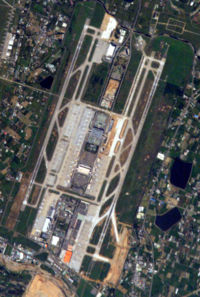
Taiwan Taoyuan International Airport It is one of three Taiwanese airports with regular international flights, and is by far the busiest international air entry point amongst them. It is the home base for China Airlines and EVA Air, which both operate a major hub at this airport. Taiwan Taoyuan International Airport is one of the two airports that serve northern Taiwan, including Taipei. The other is Taipei Songshan Airport located within the Taipei City limits, which serves only domestic flights and rarely, some special international mission flights for the President and Vice President of the Republic of China as well as other international sovereignties' chartered flights. Taipei Songshan Airport formerly served Taipei as its international airport before the opening of Taiwan Taoyuan International Airport, then known as Chiang Kai-shek International Airport, in 1979. The other two airports with regular international flights in Taiwan are Kaohsiung International Airport (Hsiaogang Airport) and Taichung International Airport, while Hualien Airport and Makung Airport are allowed and occasionally offer international charters. 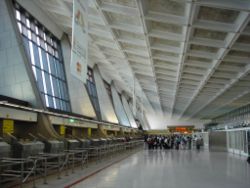
Departure passport station of Taiwan Taoyuan International Airport Terminal 1 The airport, planned as the Taoyuan International Airport, bore the name of late President of the Republic of China Chiang Kai-shek until 2006. In Chinese its former name was Chung-Cheng (Zhongzheng), the style name that Chiang Kai-shek chose for himself during his political career. The title is rendered without his family name, a traditional gesture of respect. In a situation roughly analogous to those affecting Ronald Reagan-Washington National Airport and, for many years, Cape Kennedy in the US, political associations connected with the name led some people to avoid using it. In Taiwan Chiang Kai-shek is associated with the Chinese Nationalist Party or Kuomintang and its many years of one-party authoritarian rule. Local officials in Taoyuan County and members of the pan-Green coalition often referred to the hub by the name originally associated with it, "Taoyuan International Airport." News organizations and local residents sometimes combined the two commonly used names as "Taoyuan Chung-Cheng Airport." 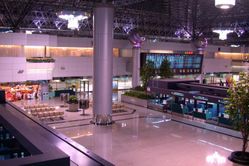
A view of the Taiwan Taoyuan International Airport Terminal 2 The airport opened (with Terminal 1) on February 21, 1979 as part of the Ten Major Construction Projects pursued by the government in the 1970s.
All text is available under the terms of the GNU Free Documentation License (see Copyrights for details). About Wikipedia Disclaimers
2007
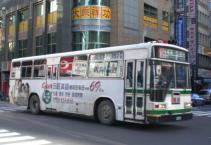
One of Taipei Buses Taipei Buses An extensive city bus system serves metropolitan areas not covered by the metro. Sometimes buses require payment upon boarding, sometimes upon exiting. Many routes, due to length, require payment upon both boarding and exiting. Riders of the city MRT system are able to use their MRT passes on buses. The pass, known as Easy Card, contain credits that are deducted each time a ride is taken. The Easy Card, Taipei's equivalent to Hong Kong's Octopus Card, is read via proximity sensory panels on buses and in MRT stations, and need not be removed from wallet or purse.
All text is available under the terms of the GNU Free Documentation License (see Copyrights for details). About Wikipedia Disclaimers
Taipei - Buses 2007
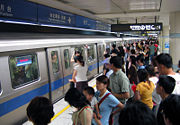
Ximen station Taipei Metro Taipei's public transport system, the Taipei Metro, incorporates a metro and light rail system based on advanced VAL technology. In addition to the rapid transit system itself, the TRTS also includes several public facilities such as Maokong Gondola, underground shopping malls, parks, and public squares. Modifications to existing railway lines to integrate into the MRT are underway. Taipei Main Station serves as the comprehensive hub for bus transportation, the Metro, Taiwan Rail, and Taiwan High Speed Rail.
All text is available under the terms of the GNU Free Documentation License (see Copyrights for details). About Wikipedia Disclaimers
2007
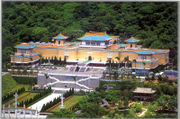
The National Palace Museum National Palace Museum The National Palace Museum is an art gallery and museum built around a permanent collection centred on ancient Chinese artifacts. It should not be confused with the Palace Museum in Beijing (note the absence of the word "National" in the latter). Both institutions trace their origins to the same institution. The collections were divided in the 1940s as a result of the Chinese Civil War. The National Palace Museum in Taipei, now boasting a much more international collection, still remains most famous for housing one of the world's largest collections of artifacts from ancient China. The museum reopened in December 2006 after several years of extensive renovations.
All text is available under the terms of the GNU Free Documentation License (see Copyrights for details). About Wikipedia Disclaimers
2007 Site Index Back to Top Photos Index Thanks for coming, I hope you
have enjoyed it, will recommend
it to your friends, and will come
back later to see my site developing
and expanding.
|